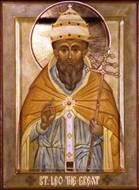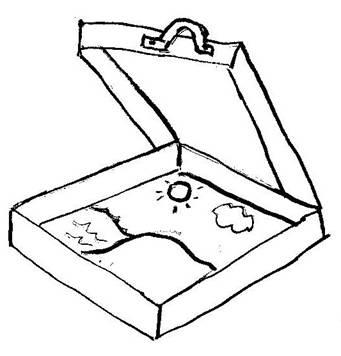Fall of Rome
FALL OF ROME
Objectives:
- Students should know that the capital of the Western Empire was the city of Rome.
- Students should know the story of St. Leo, bishop of Rome, and Attila the Hun.
- Students should know the name of the new capital of the Roman Empire, Constantinople.
Possible Lesson Plan:
- Open with prayer.
- Tell the story of the fall of Rome:
Do you remember the Emperor Constantine? He founded a new city, named for himself, Constantinople and moved the capital of the Roman Empire to his new city, far to the east of Rome. The new city was Christian from the start, full of churches. Councils were held here. Do you remember that St. John Chrysostom was bishop of Constantinople.
Far to the west, in Rome, things were not going so well. Many wild tribes lived to the
 north. They were fierce warriors and knew nothing of Christianity or the great Roman cities and culture. They were called “barbarians” by the Romans because they didn’t even speak Latin or Greek. Their speech sounded to the Romans like “bar bar bar.” They lived in little villages and tribes. But, they wanted more and more land. One of these tribes was called the Huns; their chief was Attila the Hun. Can you say that? They were wild and fierce and rode little, hairy ponies. Attila moved his army down Italy toward Rome itself. They burned and destroyed everything in their way. Finally they were at the gates of Rome. The bishop of Rome in that day was named Leo I (the first). Leo means “lion” but this Leo was not a soldier or a fighting man. But he wanted to save his city and his people. He went out the gates of the city, dressed in his gorgeous robes, with all the bishops and priests. He carried no shield or sword or spear. Would Attila and his men slaughter them like lambs before the wolves? Attila and Leo met outside the walls of Rome. Then, Attila and his army turned around and left Italy – marched away without even entering the city or killing anyone. Leo may not have been a fighting man, but he had the courage of a lion!
north. They were fierce warriors and knew nothing of Christianity or the great Roman cities and culture. They were called “barbarians” by the Romans because they didn’t even speak Latin or Greek. Their speech sounded to the Romans like “bar bar bar.” They lived in little villages and tribes. But, they wanted more and more land. One of these tribes was called the Huns; their chief was Attila the Hun. Can you say that? They were wild and fierce and rode little, hairy ponies. Attila moved his army down Italy toward Rome itself. They burned and destroyed everything in their way. Finally they were at the gates of Rome. The bishop of Rome in that day was named Leo I (the first). Leo means “lion” but this Leo was not a soldier or a fighting man. But he wanted to save his city and his people. He went out the gates of the city, dressed in his gorgeous robes, with all the bishops and priests. He carried no shield or sword or spear. Would Attila and his men slaughter them like lambs before the wolves? Attila and Leo met outside the walls of Rome. Then, Attila and his army turned around and left Italy – marched away without even entering the city or killing anyone. Leo may not have been a fighting man, but he had the courage of a lion!
Soon after, the Vandals, another wild tribe, captured northern Africa. A man named Augustine was Bishop of the city of Hippo at this time. Augustine had been a great teacher and writer of the western Church. But, Augustine was old and ill and died while the Vandals were attacking the city. They sailed up the Tiber River to Rome. They captured the city and stole all its treasures! Then another tribe called the Teutons divided up the empire. Just like Humpty Dumpty, Rome had a great fall – broken into many pieces by the barbarian tribes and never to be put back together again. Each tribe had its different customs and wanted to rule its land in its own way. The last Emperor was named Romulus Augustulus. Old Rome was beaten. It was the year 476 AD. But, the Empire in the East, with its capital in the great city of Constantinople, would continue for another thousand years.
Add St. Leo the Great to your timeline.
- True/False Questions:
True False
Leo was the bishop of Rome. Attila was the bishop of Rome.
Attila was the chief of the Huns. Attila was a lion.
Leo turned Attila away from Rome Leo fought a great battle with Attila.
without fighting.
Leo means “lion”. Leo means “monkey”.
- Try reinforcing this lesson with a little ditty to the beat of “Humpty-Dumpty”:
Good old Rome had very strong walls.
Good old Rome had a great fall.
Vandals and Teutons and Attila the Hun
Couldn’t put old Rome together again.
- Another song can teach the first 5 Patriarchates, to the tune of “Row your Boat”:
Chorus: Five centers in the Church, in the early Church;
Preaching, teaching, praying, sharing, in the early Church.
- Way out, to the west, was the Church of Rome;
Preaching, teaching, praying, sharing, was the church of Rome.
- Constantinople had the Church, “Holy Wisdom”,
Preaching, teaching, praying, sharing, “Haggia Sophie”.
- All “Christians” got their name, out of Antioch;
Preaching, teaching, praying, sharing, all in Antioch.
- The very first church of all, was in Jerusalem;
Preaching, teaching, praying, sharing, in Jerusalem.
- Last of all was Egypt’s church, in Alexandria;
Preaching, teaching, praying, sharing, in Alexandria.
- Discuss courage: What’s a lion like? Have the students come up with some characteristics of a lion. Look at a picture of a lion. How was Leo like a lion? How different? Ask the students if they have ever met a bully – someone who was mean and nasty to them. Were they afraid of the bully? What did they do – run and hide? Fight? How did Leo face Attila the Hun? Do you suppose he was afraid? Did he run away? What would have happened if he had run away? Did he fight? Would he have won if he had?

- Make a Flannel Board pizza box: Take a pizza box; most stores will give these to you. Glue light blue felt on the inside back; add cotton ball clouds in the sky and green felt grass along the bottom. Make a gray felt wall and draw stones with a marker; this can sit above the grass. Have students draw Leo in his bishop’s robes, Attila the Hun, and Attila’s horse of construction paper. Color and cut out. Glue strips of felt on the back of each figure. Can you tell the story?
8. Alternate Craft Idea: Too involved? Try this simpler craft: Make a coat of arms for Leo’s bishop’s hat. Cut two bishop’s hat shapes out of tagboard, foam, or construction paper. Staple together to make a hat. On one side, glue a cross cut from construction paper. On the other, glue a golden lion cut from gold wrapping paper. Review how the cross and the lion are involved in the story of Leo and Attila the Hun.
9. Close with prayer: Lord, help me to trust You whenever someone is mean and nasty.